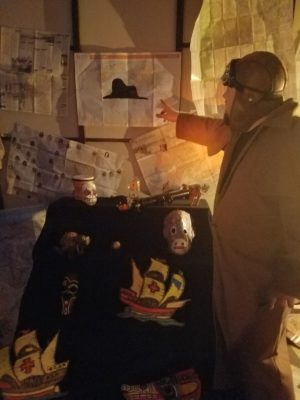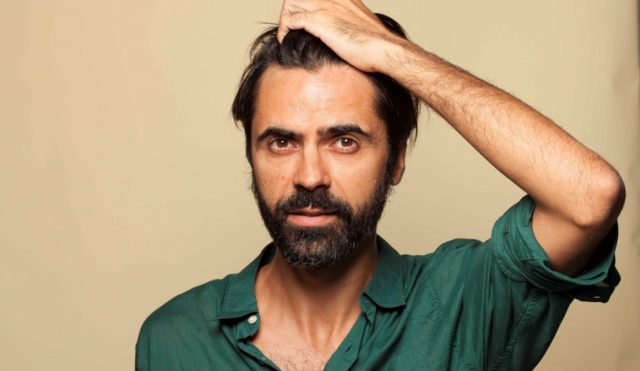As a native of Italy’s insular island to the west, Karim Galici brings a fresh slant to his work as a theater pioneer and experimental director.
Among Italian artists, Karim Galici is unique in large part because of where he comes from in Italy. The island of Sardinia, he notes, is in some ways more like its island neighbor to the north than the rest of Italy, even though Corsica is part of France.
Perhaps this explains in part why Galici tackled the French author Antoine de Saint-Exupery for the theatrical work “The Little Big Princess,” which traveled to Chicago last spring. Galici directed the immersive, sensory show that follows the classic 1943 book “The Little Prince” but with a twist. Galici bends gender by inserting female characters who were previously all male — starting with the protagonist. Such changes may have pleased the novella’s author, a famous aviator who wrote the book after his racing plane crashed in the Libyan desert and he experienced hallucinations on his way to find help.
Also accomplished beyond that play, Galici was at the center of the “In a Mosaic World” project, winner of the Sardinia Region for social inclusion. He directs theater laboratories for asylum seekers and refugees who come through the Italian government’s Sistema di protezione per richiedenti asilo e rifugiati, as well as Caritas Internationalis, a Catholic relief organization.
Galici spoke with Lou&A about the inspirations that inform his art and what it’s like to grow up and create as a Sardinian.
L&A: Tell us about your Sardinian upbringing.
Karim Galici: I am a bit like the black sheep of the family, because no one does theater — and in general no one has ever been an artist. The families I come from are of popular extraction, and probably art was something far away for them. At the same time, I have many childhood memories of parties where my relatives told jokes and sang. They had “infected” me too and without knowing it, I started doing theater like this, like a party.
Lou&A: “Karim” is not usually thought of as an Italian name. What’s the origin of it?
KG: My mother was inspired by an Indian prince: Karim Aga Khan. I have only recently discovered that probably in my distant origins there is something that comes from the Arabian territories of North Africa. In any case, the name — along with my particular features — has always made everyone think I was not Italian. When I was in elementary school, the other children were convinced that I was an Indian prince!
L&A: What is Sardinia like for an artist such as yourself? As an island culture, it seems removed from Italy, even though it’s a part of it.
KG: Sardinia, which for many is a closed culture, has given me a great open mind. Coming back to my island is always regenerating. I do not feel the same thing when I return to other parts of Italy. I’m always happy because the Italian peninsula is made of wonderful places, and people have a great ease in creating mutual understanding. But Sardinia is another thing.
L&A: How so?
KG: There is a bit of Italy but also of Spain and North Africa. You could find many similarities, but the differences would remain greater: Sardinia is unique. Living in Sardinia is for many people isolating. For me it’s almost the opposite: To have the sea all around, constantly pushes me to leave. I grew up with wide horizons and endless pools of water.
 L&A: What exactly inspired “The Little Big Princess”?
L&A: What exactly inspired “The Little Big Princess”?
KG: “The Little Prince” is one of my favorite books. There are books that you like, but it is enough to read them only once — and others that you read so many times. “The Little Prince” belongs to the latter, and I’ve read it in several languages. It was lucky that Puerto Rican director Veronica Rodriguez also loved it, and she worked with me on the direction and dramaturgy of what would become “The Little Big Princess”.
We wanted to change the prince into a princess also to have more balance with the characters — who were all male at the beginning — and for the same reason the king became a queen. We worked with puppets to make everything small and with the actors to create intimacy with the audience. For us it was very important that the spectators, starting with the children, believed in the story and immersed themselves in the drama. Then they could become in turn little princes and little princesses.
L&A: What was it like to bring the work to America?
KG: Bringing “The Little Big Princess” to Chicago was an extraordinary experience. It was the first time I worked in the United States, and I had no idea how people would react. A group of young artists, some who came from North Park University where the show took place, contributed with a passion and generosity I did not expect.
L&A: Every artist has a unique way of approaching their craft. What best describes how you approach the theater?
KG: Often we talk about style, but I like to call it the poetic. I believe there should always be poetry between the components of any artistic discipline. I’m looking for a very different theatrical approach from what people commonly call theater. In my shows, spectators do not sit in the audience: They get married between the scenes.
L&A: Married? Now that’s the theater of life.
KG: They do not see actors acting but live experiences with them; they listen not only with hearing but all the senses. I believe the sensory aspect makes me different in the contemporary theater world. I’m also experimenting with new technologies, and in my next show, video will be very important. But I want something primordial to always be at the base of everything I do — where in addition to what you see and hear, there must be important tastes and smells.
L&A: It sounds as though you’re shooting for something very participatory.
KG: In my shows, every spectator lives a unique experience in the true sense of the word. Each show is different because I always use improvised parts, and, in any case, different paths always color the experiences of each individual. At the end of the show and like in a moderate agora, each tells his experience. At this point the spectator becomes the absolute protagonist creating one of the main objectives of my theater, and that’s participation.
L&A: When you look at your work in the years ahead, what do you aspire to? What are your goals and dreams?
KG: The dream is always the same: traveling with my work. In the coming years, I would like to go back to the United States and in general bring my way of doing theater to many countries of the world. The goal is to become an internationally recognized director. The road is still long, but I have every desire to follow it.
For more information on Karim Galici, visit his Italian-language website at karimgalici.com.
The above appears in the February 2019 issue of the print version of Fra Noi. Our gorgeous, monthly magazine contains a veritable feast of news and views, profiles and features, entertainment and culture. To subscribe, click here.
 Fra Noi Embrace Your Inner Italian
Fra Noi Embrace Your Inner Italian







